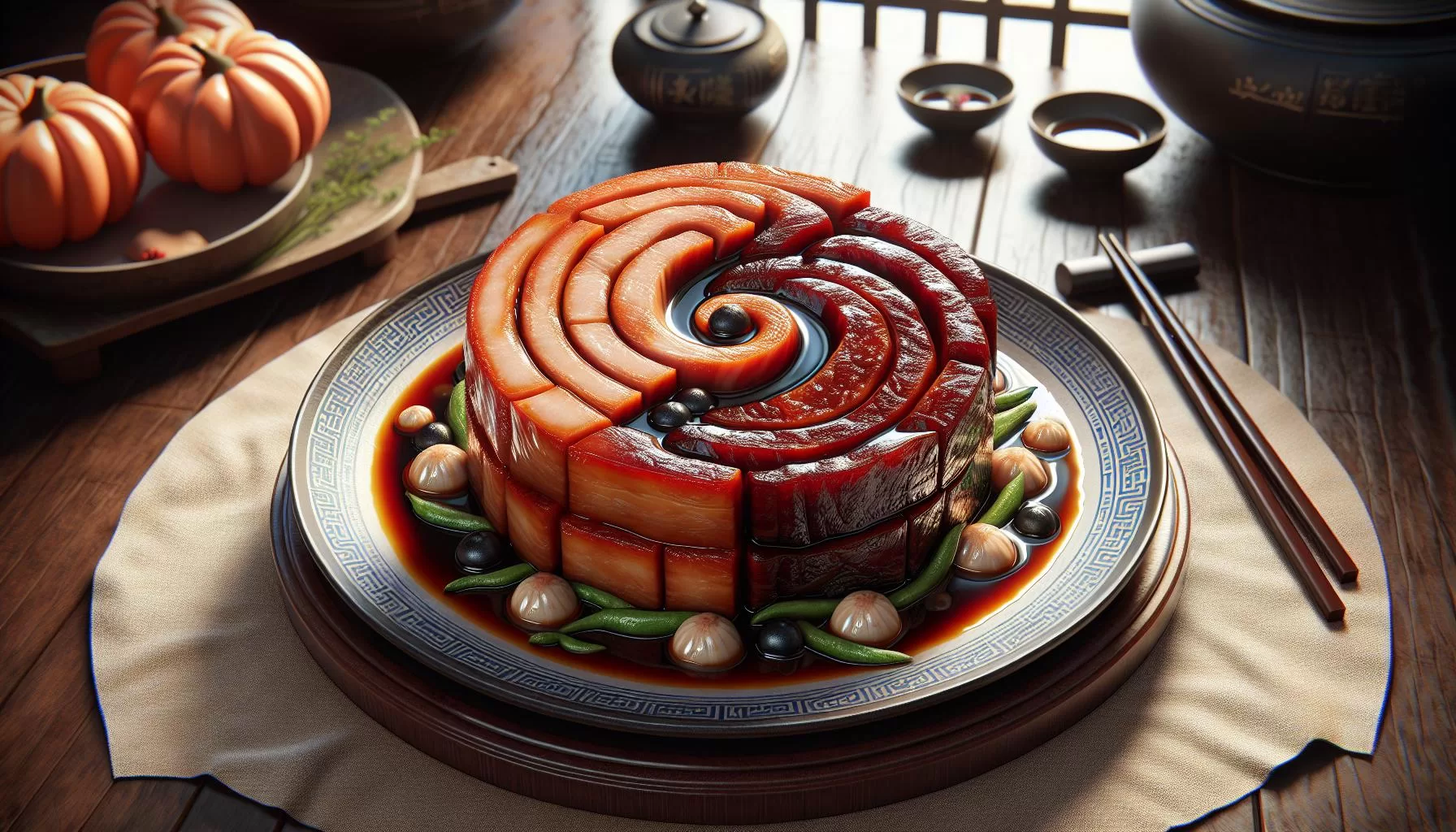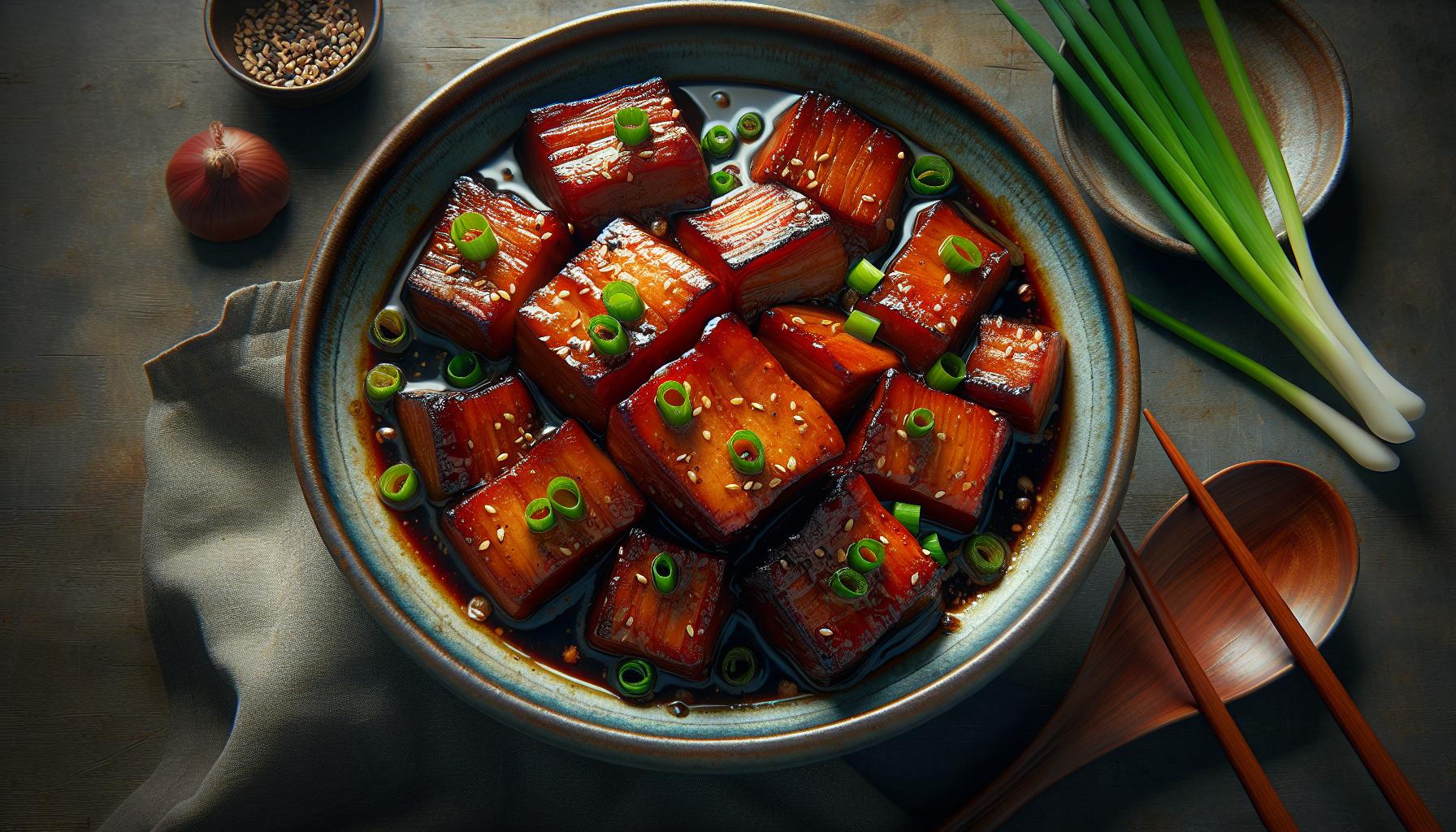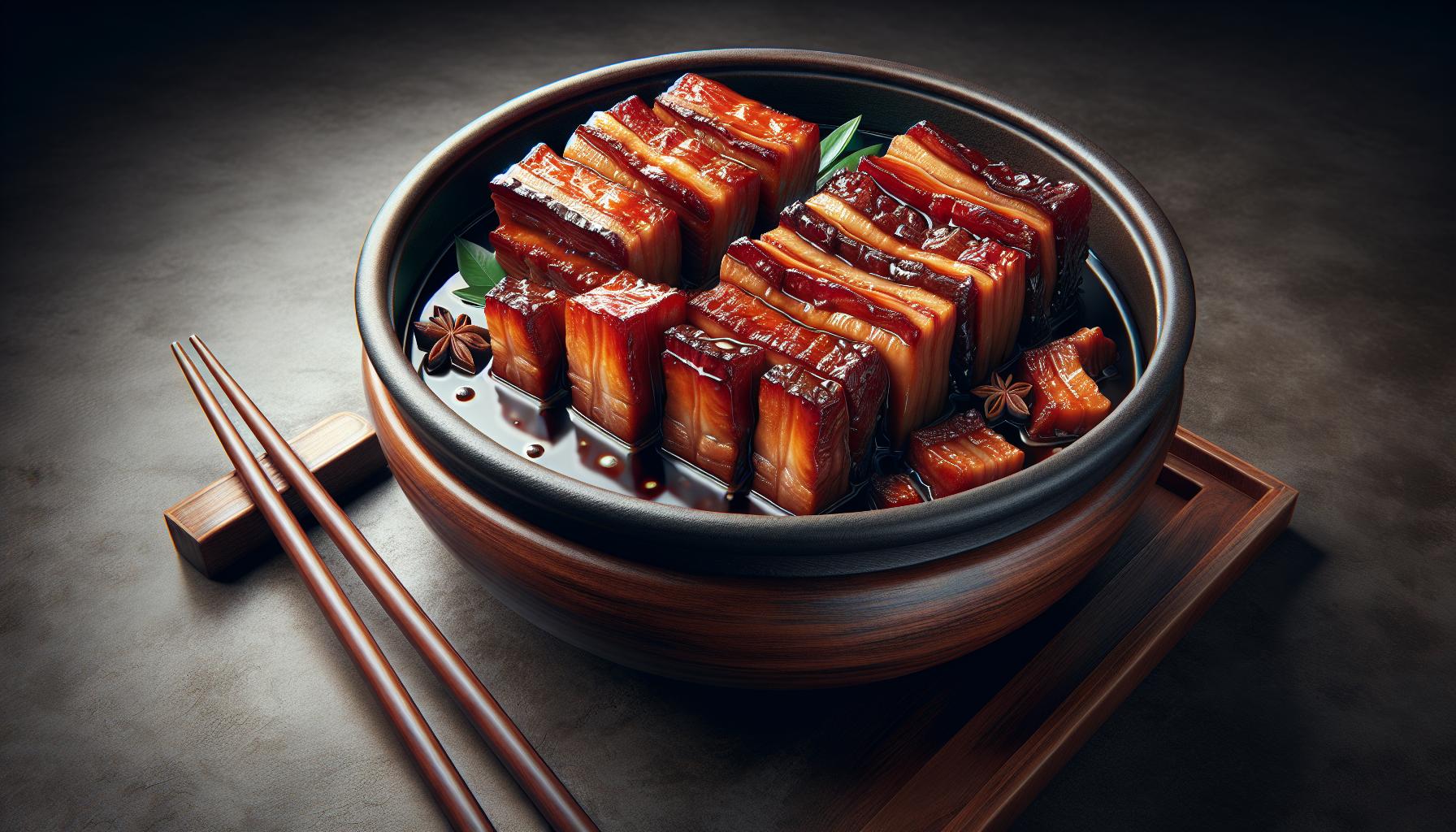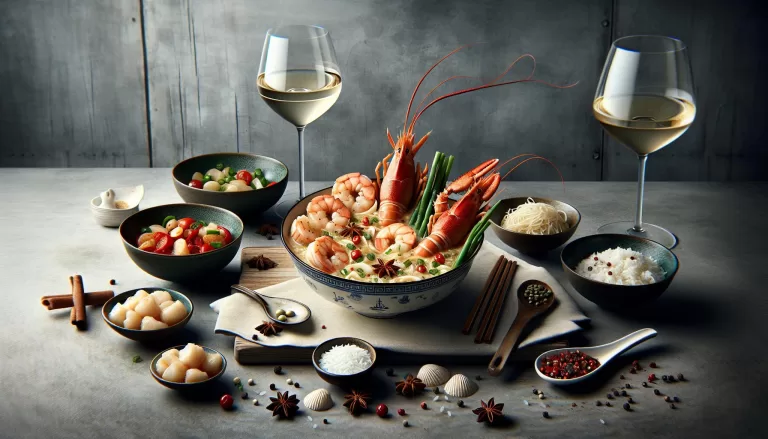Authentic Homemade Shanghai Style Braised Pork Belly Recipe – A Taste of Cultural Heritage

Ingredients for Homemade Shanghai Style Braised Pork Belly
Now that you’re ready to embark on this culinary journey, let’s dive into the specific ingredients you’ll need to recreate this savory Shanghainese treat. Remember, as you gather your ingredients, quality trumps quantity. The fresher your ingredients, the better the flavors will be in your dish.
Main Ingredients:
- Pork belly: 1.5 pounds, with skin
- Brown sugar: 1/4 cup (rock sugar preferred)
- Shaoxing wine: 1/2 cup
Sauce Ingredients:
- Soy sauce: 1/4 cup
- Dark soy sauce: 2 tablespoons
- Chicken stock: 1.5 cups
- Ginger: 2 thick slices
- Scallions: 2, tied in knots
- Star anise: 2
| Items | Quantity |
|---|---|
| Pork belly | 1.5 pounds |
| Brown sugar | 1/4 cup |
| Shaoxing wine | 1/2 cup |
| Soy sauce | 1/4 cup |
| Dark soy sauce | 2 tablespoons |
| Chicken stock | 1.5 cups |
| Ginger | 2 slices |
| Scallions | 2 |
| Star anise | 2 |
Looking for an extra touch of originality? Try adding a few Szechuan peppercorns for a unique, tantalizing numbing effect. Alternative ingredients can help you tailor the recipe to your own tastes, bringing your own personality into this traditional dish.
Some might be curious about the nutritional aspects of the ingredients. While it’s no superfood, pork belly offers substantial amounts of protein, along with vital micronutrients like zinc and vitamin B12. Additionally, using reduced-sodium variations of soy sauces and stocks can help manage the sodium content in your dish.
In the next section, we dive headfirst into the preparation and cooking process. It’s time to roll up your sleeves and ready your wok! The flavor-packed adventure is about to begin.
Step-by-Step Instructions for Preparing the Pork Belly

The journey of a phenomenal Shanghai Style Braised Pork Belly starts with solid prep work. Ready to forge ahead? Arm yourself with these strategies.
Step 1: Marinating the Pork Belly
Let’s get started. First thing’s first – you’re going to want to create a flavor-packed marinade. Grab the pork belly, ensuring it’s neatly trimmed and cut into sections that are roughly two inches long. Splash them with the Shaoxing wine and let them marinate for around two hours. The longer the better. Patience truly is a virtue here.
Step 2: Making the Sugar Color
Heat the brown sugar in a pot over medium heat until it dissolves and thickens. Be on constant guard. This can go from delicious to burnt in an instant. Once you’ve attained a thick, syrupy texture, throw in the pork. Stir till every piece is well coated.
Step 3: Infusing Flavors
Carve a chunk off your peeled ginger, mince it, and throw it into the fray along with the scallions. Add in that aromatic star anise now, and while you’re feeling brave, sprinkle in some Szechuan peppercorns. Keep in mind, less is often more with these potent little beauties.
Step 4: Cooking the Pork
Add soy sauce, chicken stock, and simmer with the lid on for approximately 90 minutes or until the pork is tender to your liking. Stir occasionally to avoid burning, and ensure the pork is deeply bathed in the braised sauce.
Remember, the magic lies in the quiet simmering process, lazily stirring the pot, and marinating your kitchen with the scent of your culinary endeavor. Could you kick up the uniqueness with alternate ingredient tips? Absolutely. Perhaps drop in a stick of cinnamon next time around, or maybe a splash of rice wine vinegar for some tanginess. Be creative, it’s your kitchen after all.
Word of warning though. With a dish this rich, keeping an eye on the nutritional aspect is wise. Factors like calories, carbs, protein, and fat will vary depending on the specific ingredients used. So make sure you’re also feeding your knowledge while you feed your tummy.
Tips for Achieving the Perfect Braised Pork Belly Texture

Getting the perfect texture for your homemade Shanghai-style braised pork belly can seem daunting. But with a bit of insider knowledge, you’ll tackle this culinary challenge like a pro.
First, master the marination. The time you marinate your pork affects the texture. For a soft, melt-in-your-mouth experience, let the pork belly bathe in Shaoxing wine for six to twelve hours before cooking. Yes, patience is indeed a virtue in the kitchen!
Second, pay attention to your simmering strategy. The goal here is to achieve a consistency where the meat’s tender but not falling apart. Make sure you’re cooking your marinated pork on low heat for a 3-hour simmering period. A slow, steady cook breaks down the pork’s tough components, turning them into gelatin that gives your pork belly that sought-after silky texture.
Third, let’s talk about ingredients impact. The use of certain ingredients can enhance the texture of your dish. Try experimenting with some non-traditional seasonings! Cinnamon or rice wine vinegar, anyone? They add not just flavor, but also help tenderize the pork belly.
Finally, while it’s tempting to dig in as soon as the pork belly’s off the stove, give it a rest! Allow the meat to stand for about 10 minutes before cutting. This helps redistribute the juices, resulting in a moist, tender pork belly.
And don’t forget about nutrition monitoring. Enjoying your flavorful culinary masterpiece doesn’t mean overlooking the dietary aspects. Being aware of the calories, protein, fat, and carb counts ensures you’re maintaining a balanced diet with this dish.
Feel equipped to achieve that perfect braised pork belly texture yet? Remember, the key lies in these tips: mastering the marination, simmering strategy, ingredients impact, and the patience to let your dish rest. Continue the culinary adventure! The perfect braised pork belly is within your reach.
Serving Suggestions and Accompaniments

Now that you’ve marinated and cooked your Shanghai Style Braised Pork Belly to perfection, it’s time to consider the best ways to serve this delightful dish. The secret isn’t just in its preparation but also in how you present and pair the flavors.
Serve it hot. This dish is best enjoyed when it’s warm. The rich, savory flavor of the pork belly meets its full potential when served hot, making every bite melt in your mouth. It’s crucial to let it rest a bit before cutting – you wouldn’t want to lose all that juiciness!
Serve with steamed white rice. The braised pork belly is typically served with steamed white rice. It’s the ideal accompaniment to balance the robust flavors of the dish. If you’re looking for a healthier alternative, consider opting for steamed brown rice or even cauliflower rice.
Consider adding veggies on the side. The dish pairs wonderfully with a variety of vegetables. Traditional choices are blanched bok choy, green beans, or steamed broccoli. The slight bitterness of the greens offsets the sweetness of the caramelized soy sauce, adding a fresh element to the meal. Plus, they contribute beneficial nutrients making your meal even healthier!
Get creative with pairing it with beverages. If you’re a fan of wines, a glass of Riesling or Gewürztraminer pairs impeccably with the dish, complementing its sweet-and-salty profile perfectly. Non-alcoholic options like green tea or a tall glass of cool water infused with mint and lemon can help cleanse the palate after each enticing bite.
Be sure to present it creatively to enhance your dining experience. Traditional Chinese porcelain plates, clean white modern designs, or even rustic stoneware can add an extra touch. Going the extra mile in presentation can make the dining experience as visually appealing as it is tasty.
With these tips in mind, your homemade Shanghai Style Braised Pork Belly will not just tantalize your taste buds but will also be a feast for the eyes. Enhance your meal with perfect accompaniments, make it look as good as it tastes, and let the compliments roll in! It’s time now to continue with more tips on advanced cooking techniques for this crown jewel of Shanghai cuisine.
Exploring the Cultural Significance of Shanghai Style Braised Pork Belly

From the bustling streets of Shanghai to your home kitchen, Shanghai Style Braised Pork Belly embodies a rich cultural history. As a remarkable pillar in Shanghai cuisine, this dish is a feast of flavors harmoniously combined. Eating it isn’t just about the meal, it’s an immersion in centuries-old culinary tradition.
In Chinese culture, pork belly is more than an ingredient. It signifies prosperity and high living standards. With fat and lean layers beautifully marbled, pork belly mirrors the notion of yin and yang balance. It’s about achieving harmony that’s integral in Chinese philosophy.
Historically, this braised recipe caught culinary attention during the mid-Qing Dynasty. It was then when Shanghai’s trade and commerce peaked, leading to the city’s outlook on high-quality, flavorful food. The recipe’s delightful blend of soy sauce, sugar, and Shaoxing wine emphasized the locals’ desire for a sweet and savory balance.
Today, Homemade Shanghai Style Braised Pork Belly isn’t just enjoyed in Shanghai but all over the world. Its global acclaim indicates how food can transcend borders, connecting people. The recipe is a testimony that wherever you are, you can partake in traditional Chinese culture one bite at a time.
In your culinary journey with this recipe, you aren’t only learning to prepare a meal. You’re honoring an age-old tradition, transporting flavors from historic Shanghai to your present household. You’re aligning with a community that appreciates and celebrates rich, culturally embedded flavors.
So, the next time you’re serving this braised dish, remember that you’re not just sharing food. You’re delivering a slice of Shanghai’s proud culinary history, contributing to a legacy of flavor-packed meals reverberating with cultural significance.
Conclusion
So there you have it. By making your own Shanghai Style Braised Pork Belly, you’re not only treating yourself to a mouthwatering meal but also participating in a rich culinary tradition. This dish, deeply rooted in Shanghai’s history, offers a unique blend of prosperity symbolism and yin-yang balance. It’s a testament to the power of food in bridging cultural gaps, bringing people together over shared flavors. Whether you’re a seasoned cook or a culinary novice, preparing this dish is a way to experience Shanghai’s vibrant food culture right in your own kitchen. So go ahead, honor this centuries-old tradition and enjoy a taste of Shanghai’s culinary heritage. You’re not just cooking a meal, you’re contributing to a legacy.





